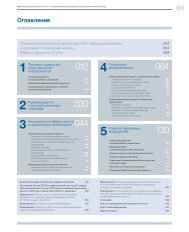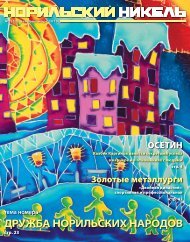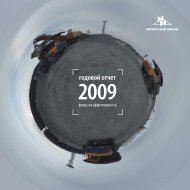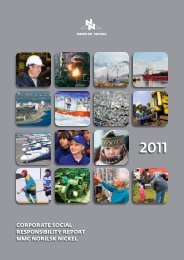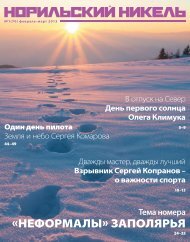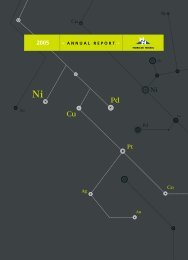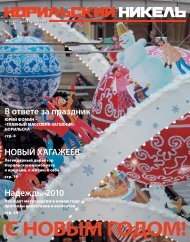Norilsk Nickel Harjavalta
Norilsk Nickel Harjavalta
Norilsk Nickel Harjavalta
You also want an ePaper? Increase the reach of your titles
YUMPU automatically turns print PDFs into web optimized ePapers that Google loves.
SAFETY DATA SHEET Page 5 / 9ELECTROLYTIC NICKELDate 26.2.2013 Previous date: 11.4.2012 Version: R1.4RISK VALUES: EnvironmentCompartmentCategory / Threshold Value/ Relative Absorption Factor (RAF)/ Assessment Factor (AF) / PNEC/Comment ValueAquaticFreshwater/ 7.2 ug Ni/L (HC5) /Not relevant /2 /3.6 ug Ni/L /Bioavailability correction availableMarine /17.2 ug Ni/L (HC5) /Not relevant /2 /8.6 ug Ni/L /No bioavailability correction availableSedimentFreshwater/ Pending outcome of testing program/Not relevant /Pending outcome of testing program/Pendingoutcome of testing program/Pending outcome of testing programMarine /Pending outcome of testing program/Not relevant /Pending outcome of testing program/Pending oftesting programTerrestrial / Soil /59.8 mg Ni/kg (HC5) /Not relevant /2 /29.9 mg Ni/kg /Based on10th percentile of abiotic soilpara-meters in EU. Bioavaila-bility correction availableSewage Treatment Plant (STP) /Microbial activity 33 mg Ni/L (Lowest NOEC) /Not relevant /100 /0.33 mgNi/LSecondary Poisoning: AquaticOystercatcher (aquatic bird) 123 mg Ni/kg /1 /10 /12.3 mg Ni/kgEuropean otter (freshwater-mammalian) 23 mg Ni/kg /0,025 /10 /2.3 mg Ni/kgHarbor seal (marine mammalian) 46 mg Ni/kg /0,025 /10 /4.6 mg Ni/kgSecondary Poisoning: TerrestrialEarthworm eating bird 85 mg Ni/kg /1 /10 /8.5 mg Ni/kgShrew (terrestrial mammalian) 1.2 mg Ni/kg /0.036 (100% worms) /10 /0.12 mg Ni/kg0.025 (30% worms, 70% isopods)8.2 Exposure controls8.2.1 Appropriate engineering controlsAvoid contact with skin and eyes. Do not breathe dust. Avoid repeated exposure. Wear suitable protectiveequipment. Ensure that eyewash stations and safety showers are close to the workstation location. Removesoiled or soaked clothing immediately. Clean skin thoroughly after work. At work do not eat, drink, smoke ortake drugs. Keep away from food, drink and animal feedingstuffs. Keep working clothes separately.8.2.2.1 Respiratory protectionUse a respirator with filter model P3 (DIN 3181).8.2.2.2 Hand protectionProtective gloves: Leather;8.2.2.3 Eye/face protectionFace-shield;8.2.2.4 Skin protectionClothing as usual in the chemical industry.8.2.3 Environmental exposure controlsThe employer shall fulfill requirements of IPPC Directive.SECTION 9. PHYSICAL AND CHEMICAL PROPERTIES9.1 Important Health Safety and Environmental Information9.1.1 Appearance Appearance: SolidColour: Silver9.1.2 Odour odourless9.1.3 Odour threshold Not applicable.9.1.4 pH insoluble



